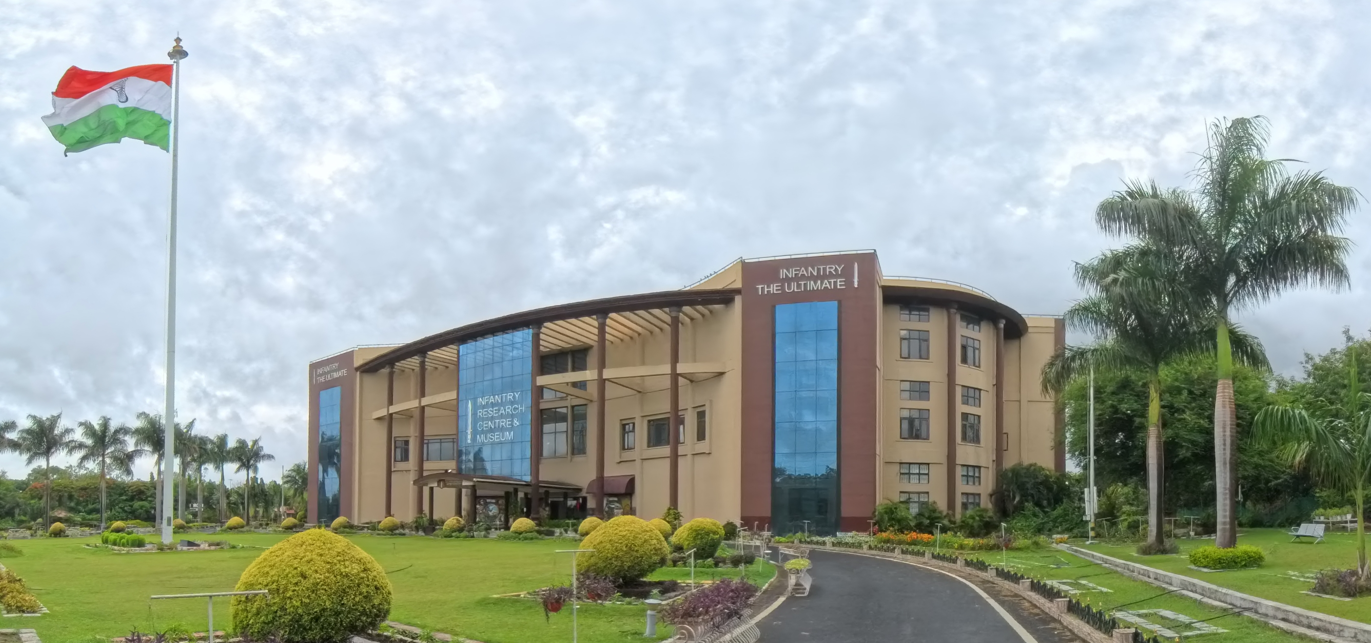
About : Infantry Research Centre and Museum
(Mhow, Madhya Pradesh)
The Infantry Research Centre & Museum at Mhow is the first internationally benchmarked military Museum in India. The Museum was conceptualized in 2003 and the construction commenced in 2015. The museum showcases the evolution of the Indian Infantry over the ages, the battles fought and its achievements over the years with the theme line “INFANTRY THE ULTIMATE”. It is an institute of pride for all citizens to be part of the rich heritage of Indian Infantry.
In Infantry Research Centre & Museum, you will be exhilarated to see the vast beautifully maintained lawns with seasonal flowers blooming in the variety of colours. The central lawn houses a huge 106 ft high National Flag which is the centre of attraction for the public.
The Museum is laid out in three floors covering the evolution of the Infantry and its achievements from 1740 onwards. It is further divided into various periods of History and major wars fought. It also has separate enclosures for every Regiment, Hall of Fame, Research Room, Library and Training, Special Operations besides various other interesting galleries.
- Orientation Room : This room depicts the evolution of Indian Infantry since inception till date.
- Chiefs of Army Staff & Field Marshals Corner : A corner has been dedicated towards the infantry officers who has risen to the post of the Chief of Army Staff and Field Marshals. It houses their valuable items, souvenirs and uniforms.
- Corridor 1747 – 83 : This area depicts the period from 1747 to 1783, covering the European Trade Centres, Battle of Plassey, Carnatic Wars, Battle of Buxar and British Possessions in India till 1767.
- 1784 – 1857 Room : This room is dedicated towards the history of Indian Army from 1784 to 1857. It informs the viewer about the origin of the Colonel of Regiments – 1 st Re organisation, Rise of Marathas, Anglo Gorkha War, Rise of Sikh Empire and the first spark of the independence.
- 1858 – WW I : As you enter, you see an ‘Indian soldier tied in front of a Cannon. This is how the Indian soldiers who were convicted of mutiny were punished by blowing them tied to a cannon. This depicts how the Indians were silenced from raising their voice for independence. This room portrays the deployment of the Indian Infantry, Martial Race Theory, Battle of Saragarhi and an installation representing the Life of Soldier in Trenches.
- WW I Area / 8 pillar area : This area is dedicated for the Victoria Cross Awardees during World War I.
- Corridor – 1962- 1965 : This corridor shows how Indian Army transformed and modernized post 1962 War.
- 1965 Indo Pak War Room : This room is illustrating the Pre- War escalation, Battle of Hajipir, Op Hill, Dograi, Barki, Asal Uttar and Phillora. It also has gallantry awardees corner and ends with the lessons learnt from 1965 Indo Pak War.
- 1971 Indo Pak War Room : This enclosure depicts the Birth of a Nations, liberation of the East Pakistan with special reference to major battles in the war fought by the Indian Infantry.
- Hall of Fame : The ground floor of the building ends with a Hall of Fame giving the viewer a gist of the main gallantry awardees of the Indian Infantry after 1947 as well as other Infantry men who have distinguished themselves during the service.
- 1999, Kargil War Room : The room houses the information of the 1999 Kargil War and also has a space available for the events from 2000 onwards for future display.
- Regimental Room : Indian Army has 27 Infantry Regiments with rich Military heritage and traditions. This Regimental Room showcases all the Indian Infantry Regiments & traces the evolution of the present system from 1747 onwards. Being the central attraction for Infantry Men, this room has a dedicated cubicle incorporated with the Kiosk hosting detach of each Regiment of Indian Army.
The Infantry Research Centre has various other rooms planned like Infantry School. Mhow Room, Special Ops, Counter Insurgency/ Counter Terrorism Operations, Making of a Soldier and an Officer and various others on which the research and designing work is in progress. Once completed in all respects, the Museum will become a renowned place of national pride for us Indians.
